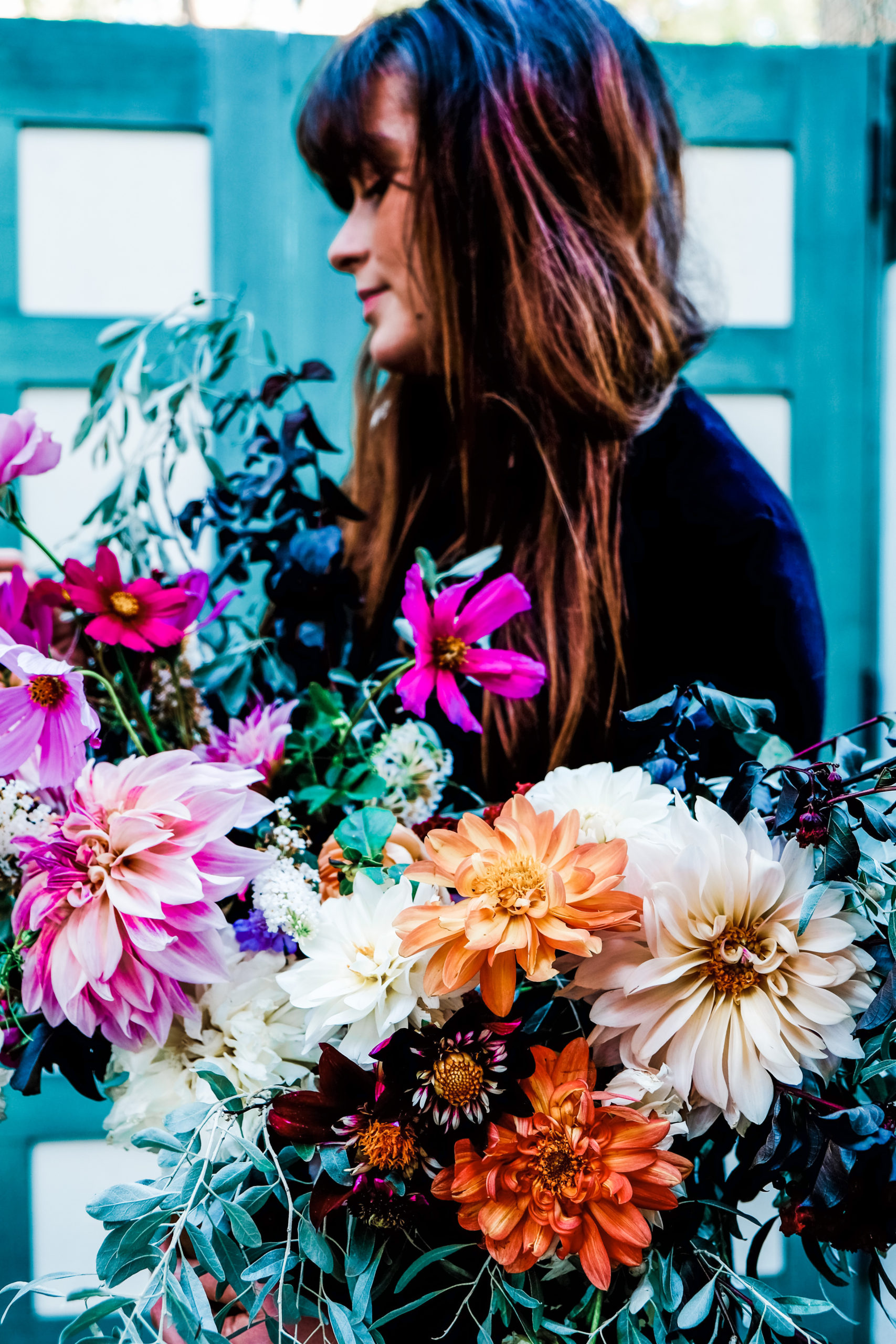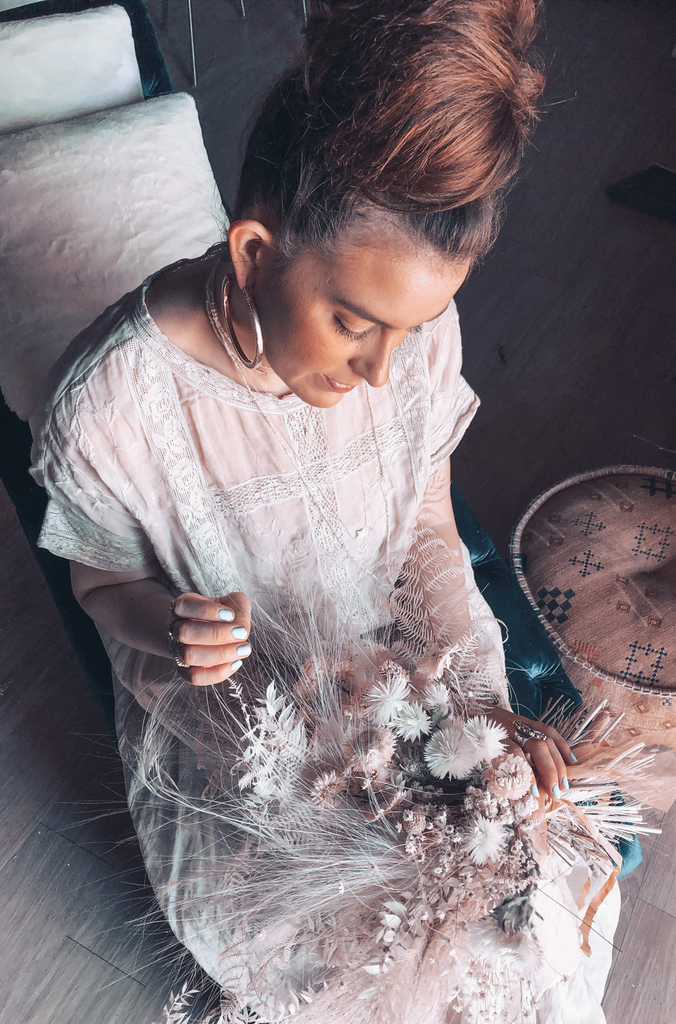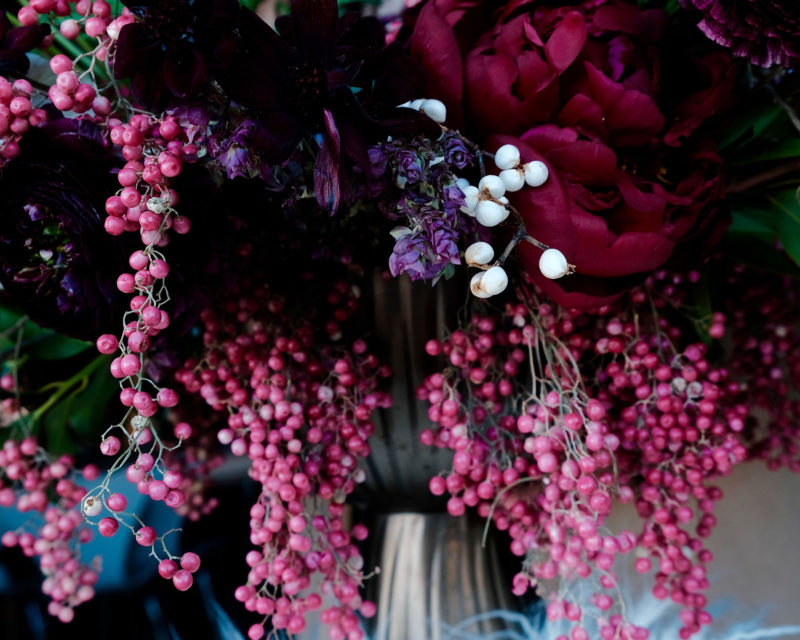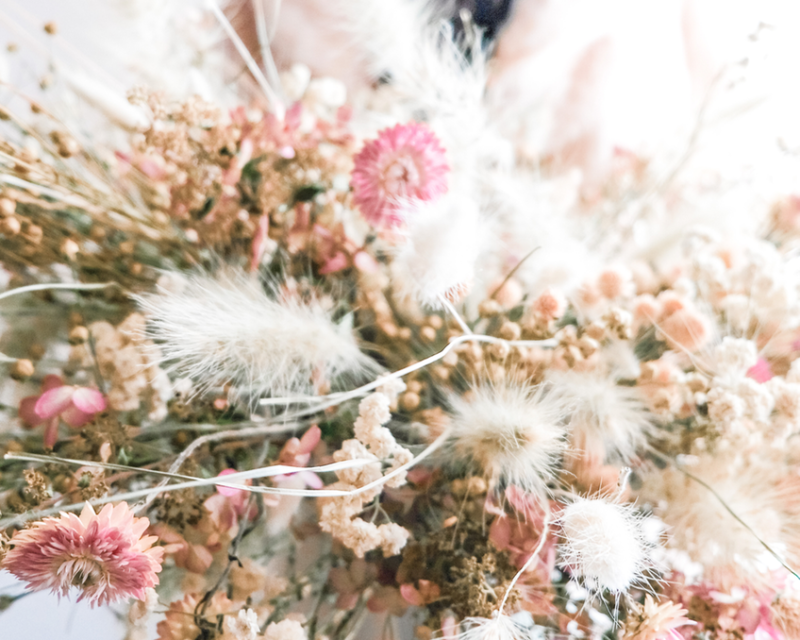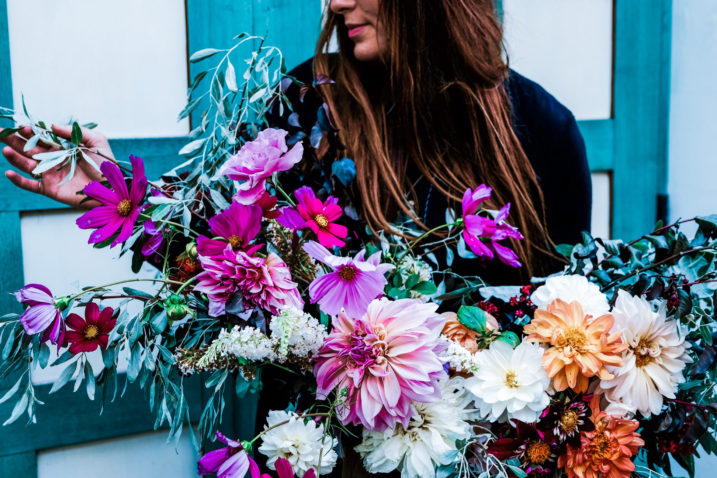
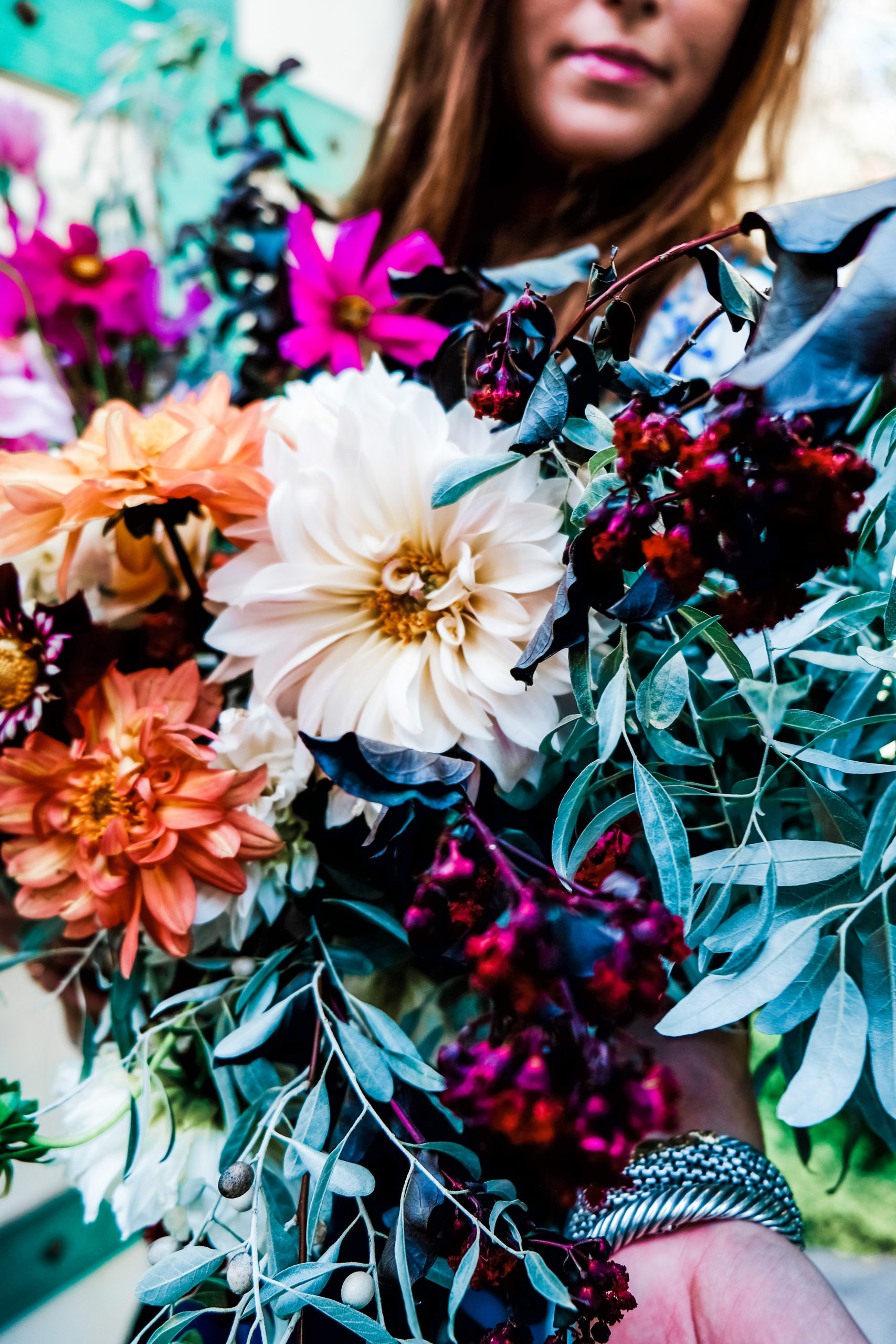
 Late summer, and I’m foraging and gleaning dahlias from my flower farm, cosmos, zinnias, cutting garden roses, wild grape vine, indecipherable weeds I find pretty. Lady of Shallott, a heady apricot rose, makes me feel some kind of way. I like and want things in some shade of honey, something that feels languorous like the Indian summer.
Late summer, and I’m foraging and gleaning dahlias from my flower farm, cosmos, zinnias, cutting garden roses, wild grape vine, indecipherable weeds I find pretty. Lady of Shallott, a heady apricot rose, makes me feel some kind of way. I like and want things in some shade of honey, something that feels languorous like the Indian summer.
I have foraging and flower daydreams. In these, I have a little yellow house with climbing roses, honey roses, growing onto the house, draping over the shutters. A very sexy magnolia tree that lends me its flowers. Cup and saucer blooms that I bring indoors, along with the roses. And of course, in this imaginative scenario, I know of several places in the wild, where I go gathering little and indecipherable things, like elderflower, baby strawberries, tiarella flowers, pea pod vines (my flower daydreams apparently span ecosystems). My own life is arguably more interesting and more textured than the daydream, but its flower offerings aren’t as prolific.
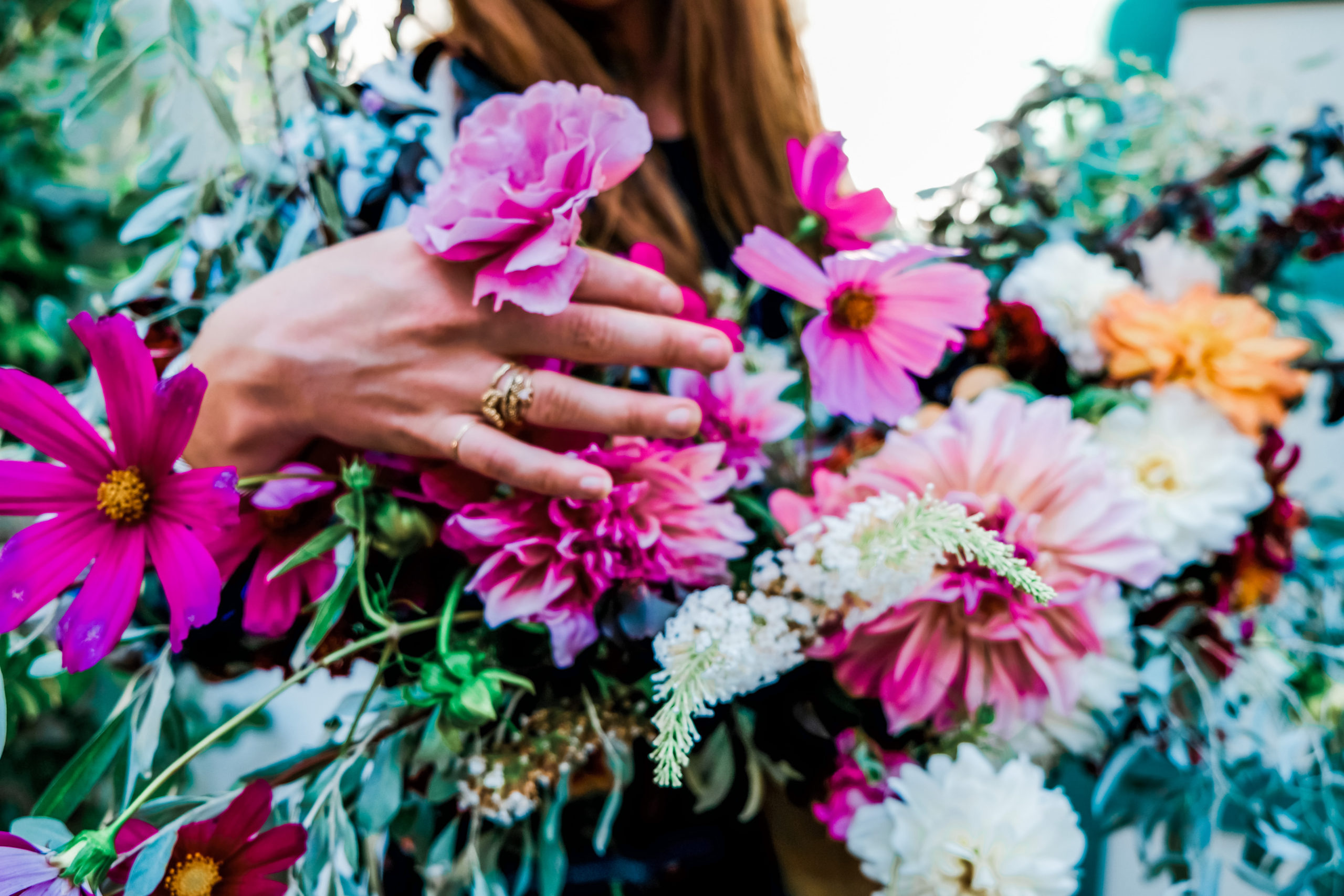
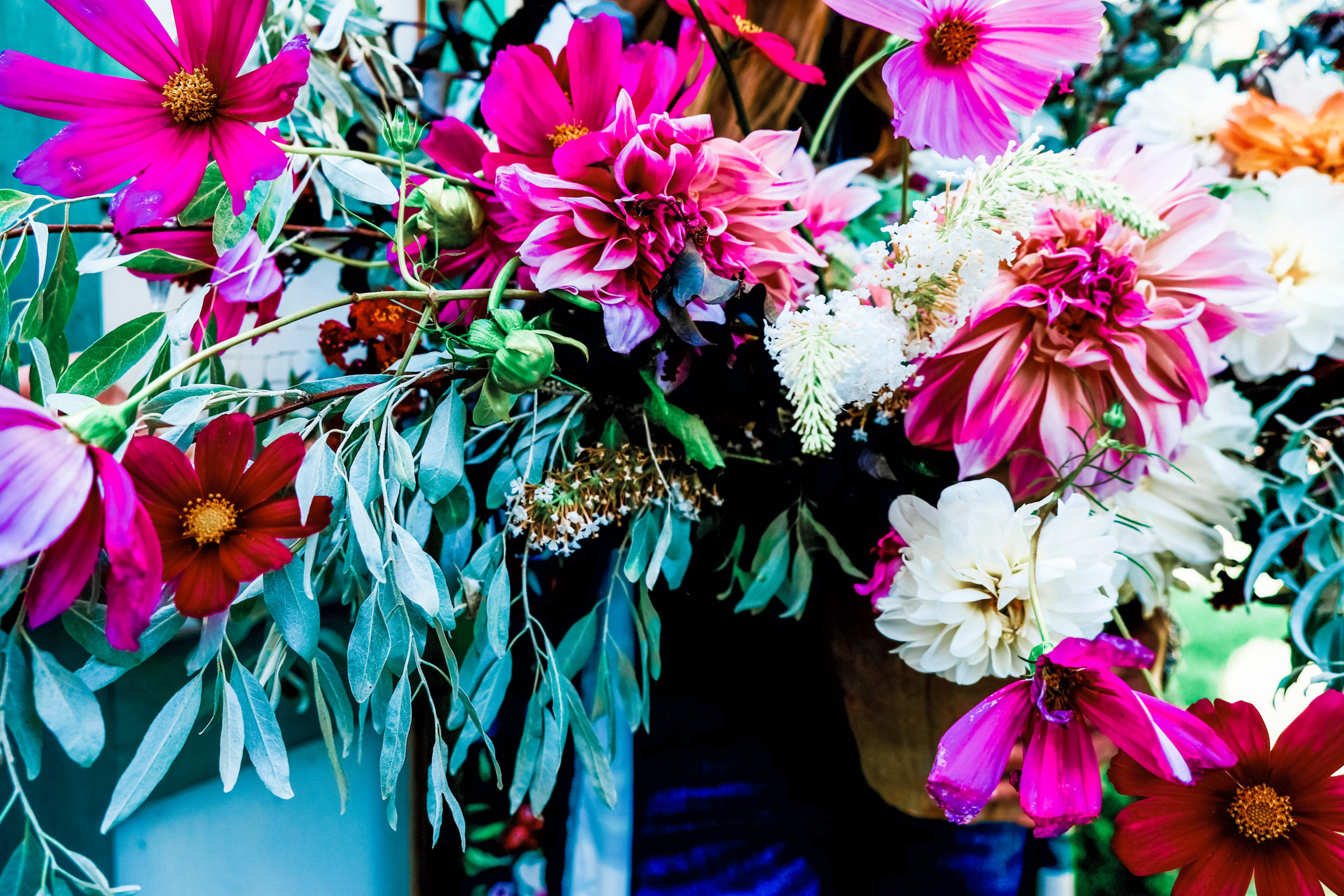
Still, I am devoted to finding, foraging, and gleaning flowers, wherever I have grown them and wherever they may find me. No flower order can, for me, match the joy of finding something in its natural habitat. Foraging is about meeting serendipity halfway. The flowers don’t exactly find you—you’re in pursuit of them—but what you find often disarms and delights. You were looking for heirloom roses, but instead something in the kitchen garden has gone beautifully to seed. You receive what you didn’t know you needed. It’s a process that can become intoxicating.
When I try to articulate why it is that I love foraged, natural product so much, I struggle to know where to begin. How can neat bunches of imported roses, sorted in cardboard and plastic, compare to the experience of finding wild roses or baby rose vines, tangled, gnarly, and vibrant? The question, I feel, answers itself. The one experience is so real—visceral, and I would even say spiritual. The other, so—well— appropriate for the grocery store. Nature and especially flowers foster connection. I don’t want my flowers commodified, tamed. I want to feel them, cut them down, sift through them, be hurt by their thorns. And then I want to arrange them in a way that honors their aliveness.
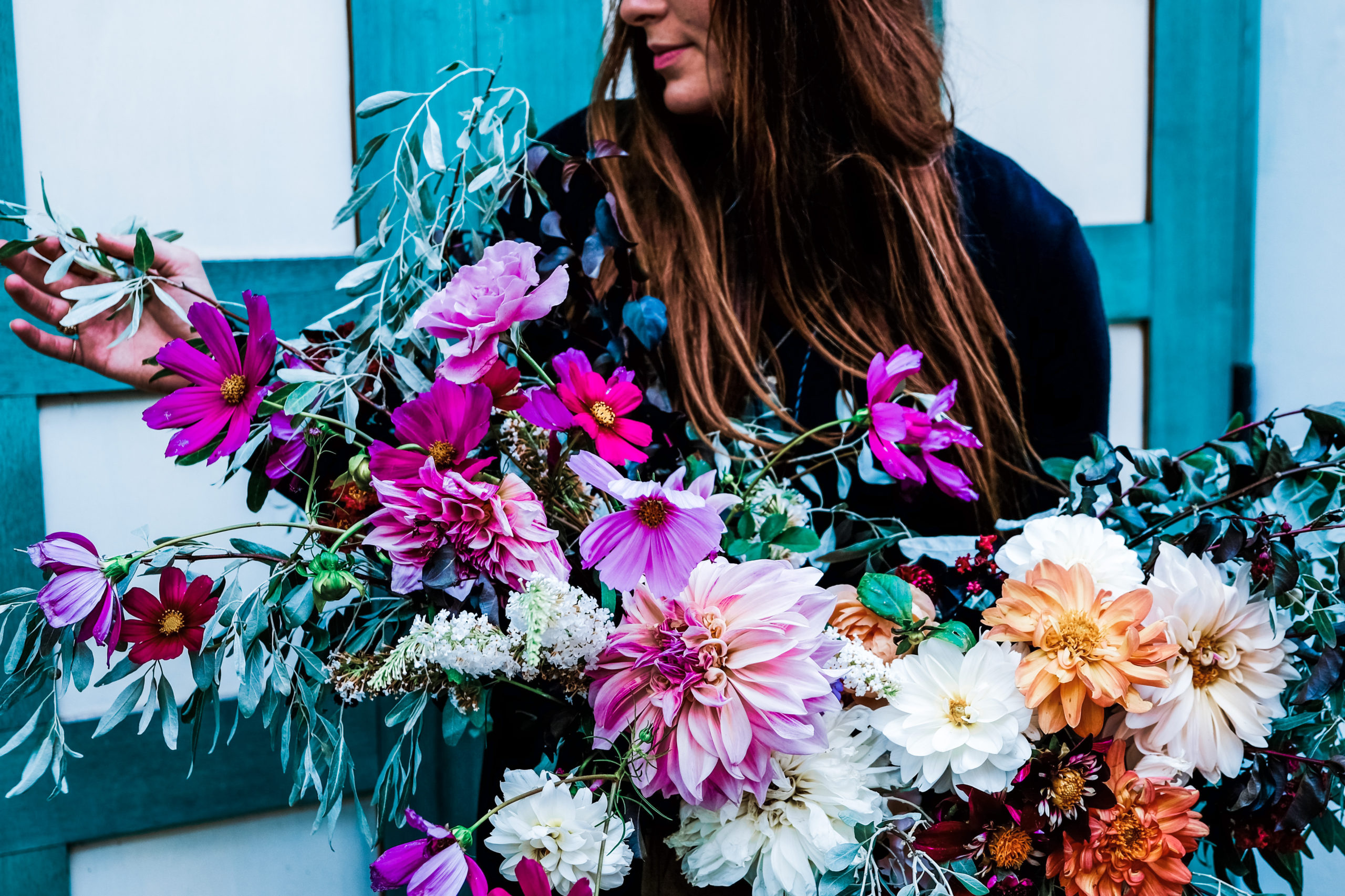
This desire for what is ‘real’ or ‘alive’ is not peculiar to me. Most of us in the flower world (and beyond) want distance from the big agribusiness model and method of thinking. The thing about big agribusiness is that it perpetuates this genetically modified, treated food that will last longer than it should last (we know this already). It’s about shelf life. The product of this is the too-red, too-perfect tomato. The almost-plastic lemon and the apple that, disconcertingly, still looks pretty good after being neglected for eight days in the fridge. I understand that shippability and shelf life are real concerns, ones these industries are driven by. Still. It’s enough to make a girl long for markets and food stalls, apricots and lemons with lumps and bumps, fresh and imperfect, full of flavor and nutrition. Or better yet a kitchen garden, where you walk to pick herbs and gather vegetables for the evening meal.
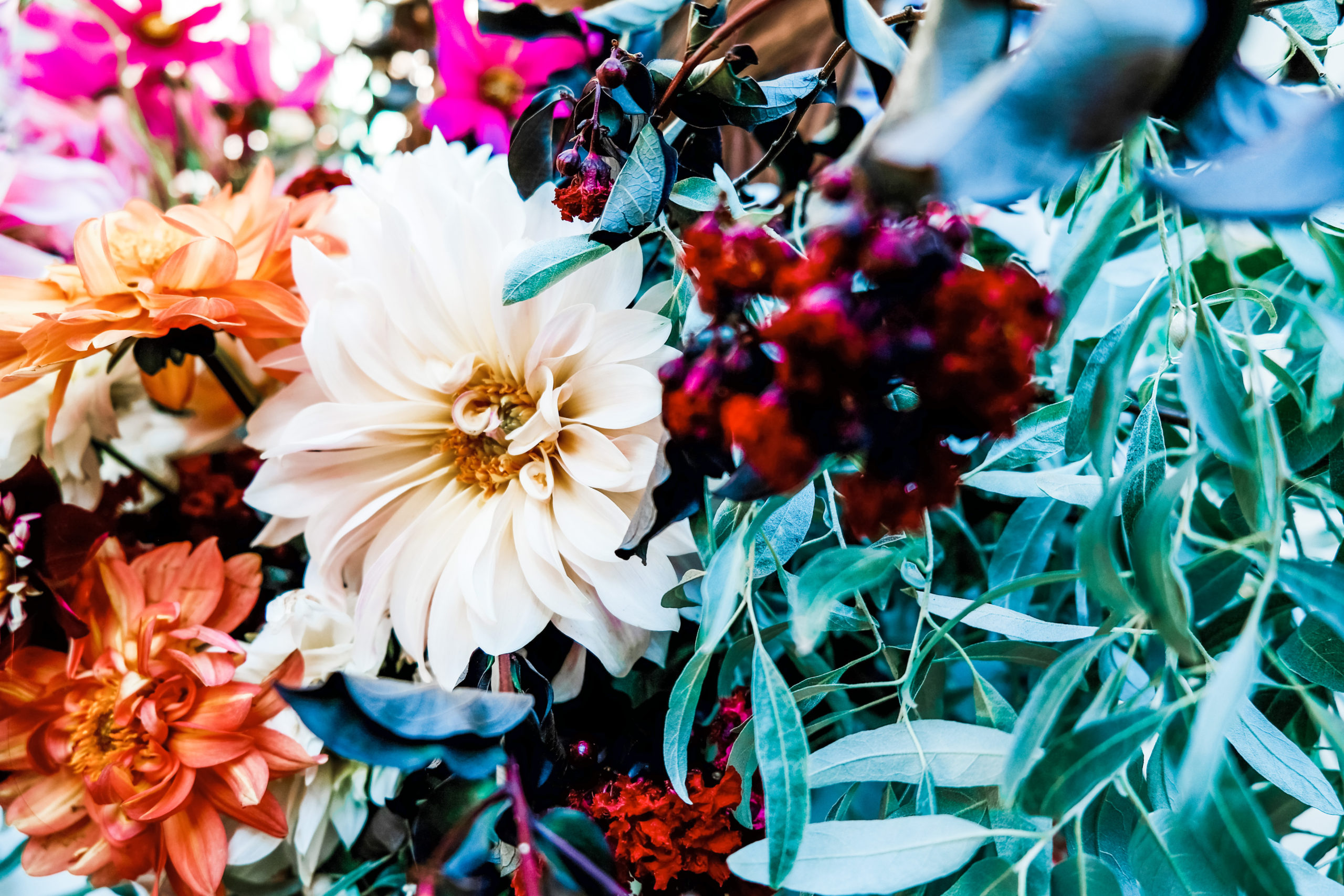
The big agribusiness model is, of course, alive and well in the flower world. We see it in the South American roses that last for two to three weeks, much longer than they should, because they have been treated with pesticides. The stiff, standard, almost plastic product that just hangs on and on. (It’s a longstanding joke on wedding productions. If you need something to hold up, it won’t be your prized garden roses. It’s the damn Belle of Ireland, hanging in the back of the cooler, like duuuuuuuude. I’m four weeks old and I’m allliiiiiiiive.) This product has shelf life, but it comes at what cost?
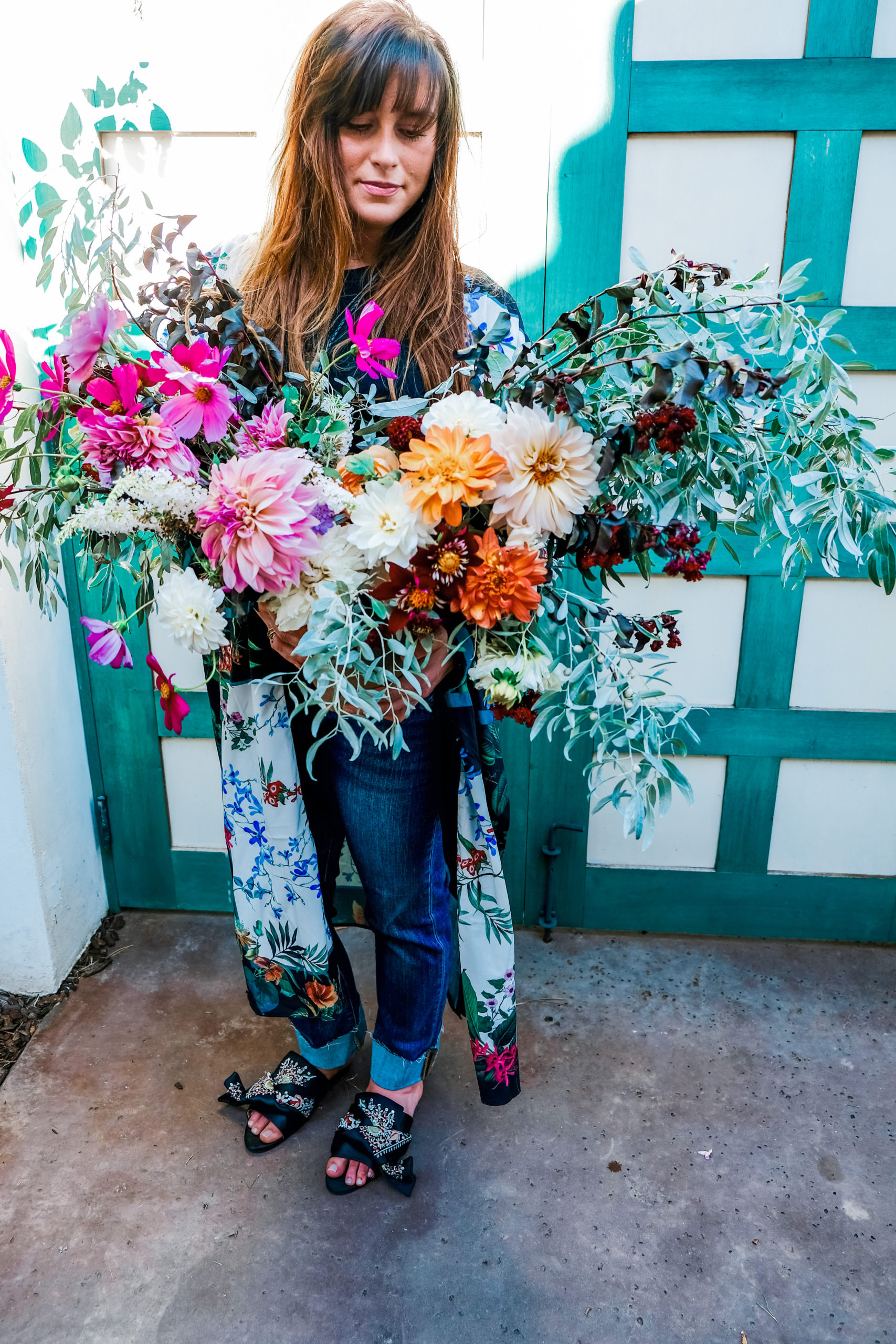
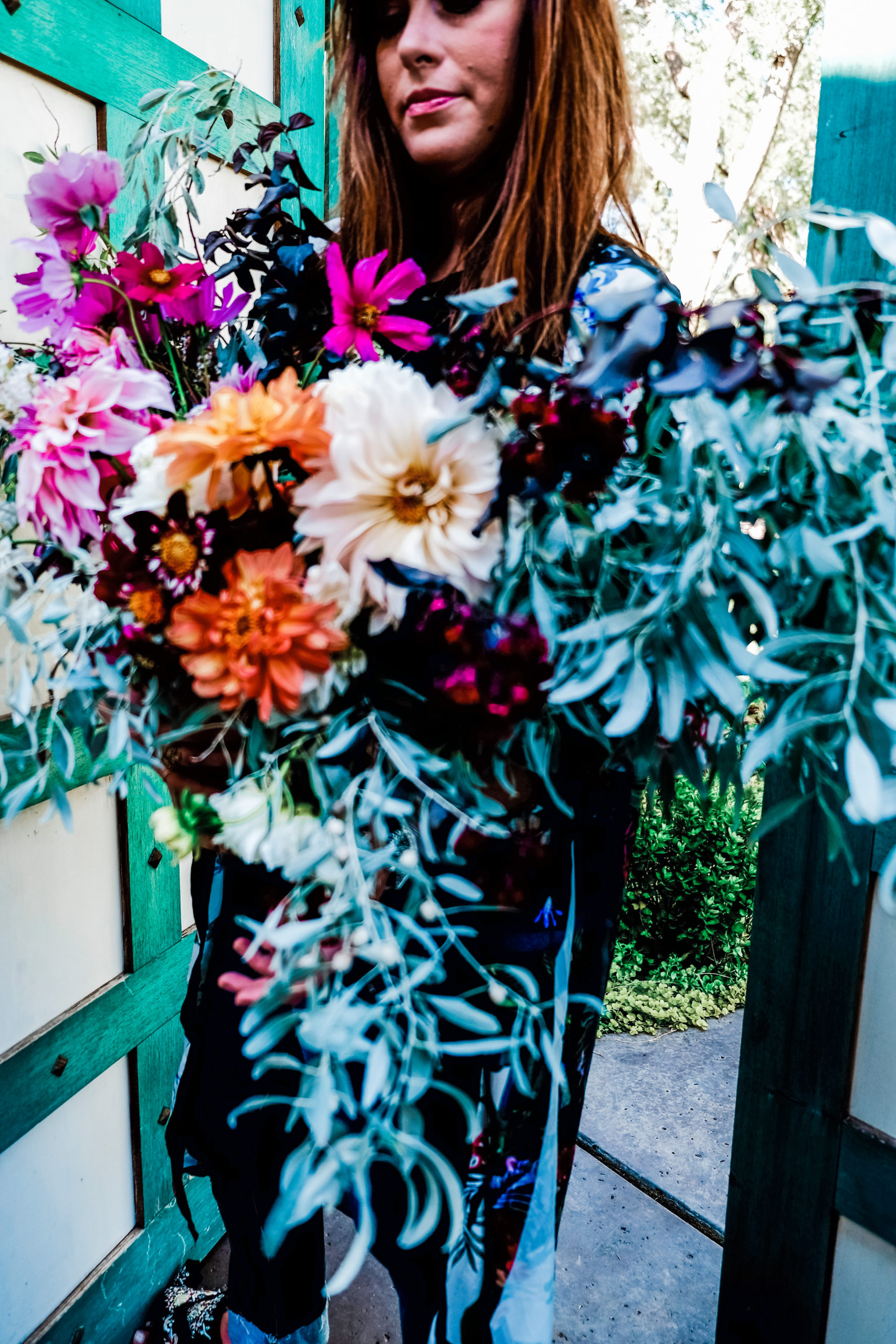
Sometimes the best way of learning about these issues is through a story, and no one tells this story more aptly than Dan Barber, chef of Blue Hill Restaurants in Greenwich Village and Stone Barns. In his book The Third Plate, Barber speaks of one watershed morning at Blue Hill. The kitchen was humming with its usual activities, when in walked one of the head growers, brandishing a bunch of huge and beautiful carrots. Barber tasted them, and agreed that they were the sweetest carrots he had ever tasted. Fortunately, he could prove that sweetness, in an empirical way. Measured on the kitchen refractometer (a device that measures parts per billion of sugar), this carrot yielded 16.9. For fun, chef compared this with a gourmet carrot that served as the sort of kitchen workhouse, a carrot used in stews and stocks and the like. (Said carrot is not dissimilar from something you and I might buy from Whole Foods.) It’s yield? 0.00.
It always goes back to the soil. (Dan and Ira Glass have this fascinating conversation here—a must-listen for anyone remotely interested in sustainable food, the implications of traditional growing practices, and thinking beyond the farm-to-table movement. Also. Most of what I am about to state is straight-up summarizing of a portion of this talk. I’m not a soil biologist. Just an avid listener and learner; bear with me.) Our understanding of soil biology is not conclusive, but what we do know is that lively, active, soil is best—a soil full of microbial communities that essentially eat one another. An astute reader of soil can see clearly what soil is asking for, because it leaves us all these little clues. The presence of Queen Anne’s Lace, Barber explains, should tell us that our soil lacks fertility, while yellow flowers tell us that the soil needs zinc. When we care about building up the microorganisms in our soil, we will give it the amendments it’s asking for.
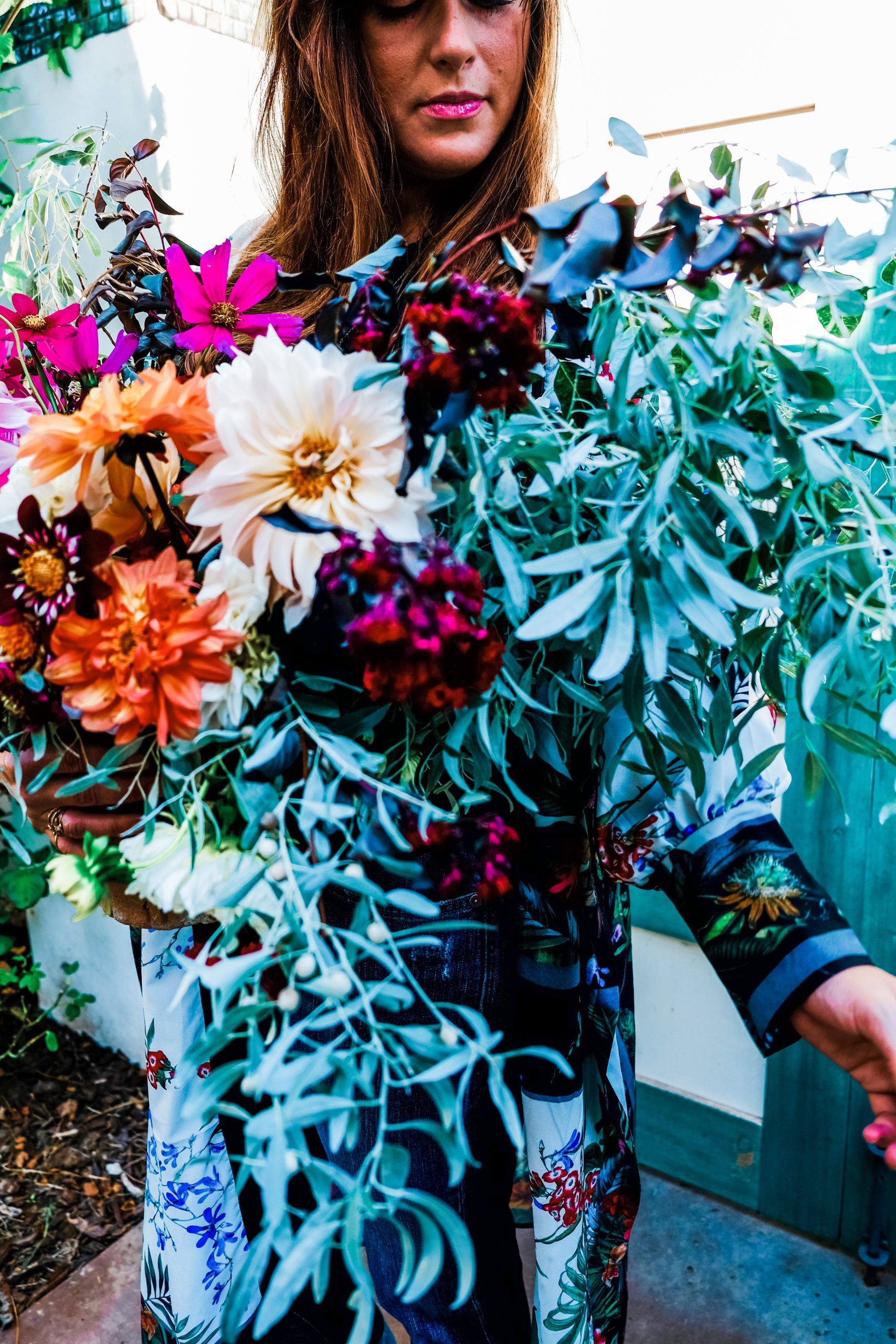
The agribusiness approach will have the grower, meanwhile, pour liquid nitrogen onto the soil. When you input chemical fertilizers into a soil, you’re essentially inputting certain chemicals that we deem necessary for life and growth—Nitrogen, Phosphorous, Potassium. But you’re not creating a vibrant community of soil microorganisms. Your soil is not lively, active soil—your soil is, in fact, denuded. Nitrogen fertilizers literally bomb the soil, wiping out microbial communities. Fed nitrogen, things will grow—plant poundage and yield will, in fact, be huge—but they will be flavorless and nutritionless. One might say soulless. Enter the too-huge, too-perfect red tomatoes. The everlasting apples. The white roses that peculiarly last for three weeks.
On the other hand, when soil is fed the things it needs—be it zinc, sulfur, etc.—the soil responds with health-giving, life-giving yields. They are tasty, nutritious, real, and beautiful. Gorgeously sweet carrots and cauliflower. Lovely farm fresh dahlias, with their distinct, clean, almost mint fragrance. Good soil yields food that is full of flavor and nutrition, and flowers that look and feel… real. Exquisitely so.
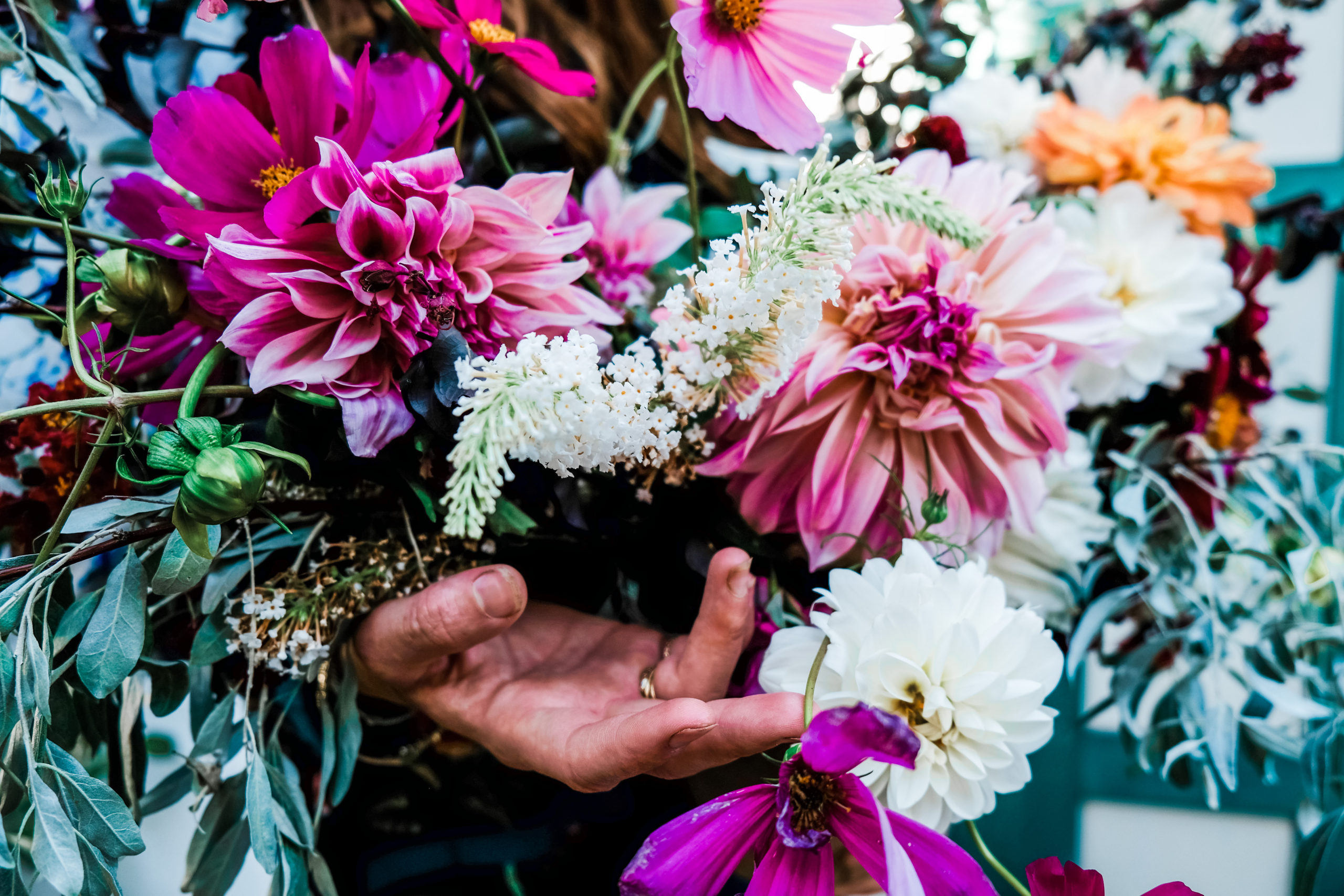
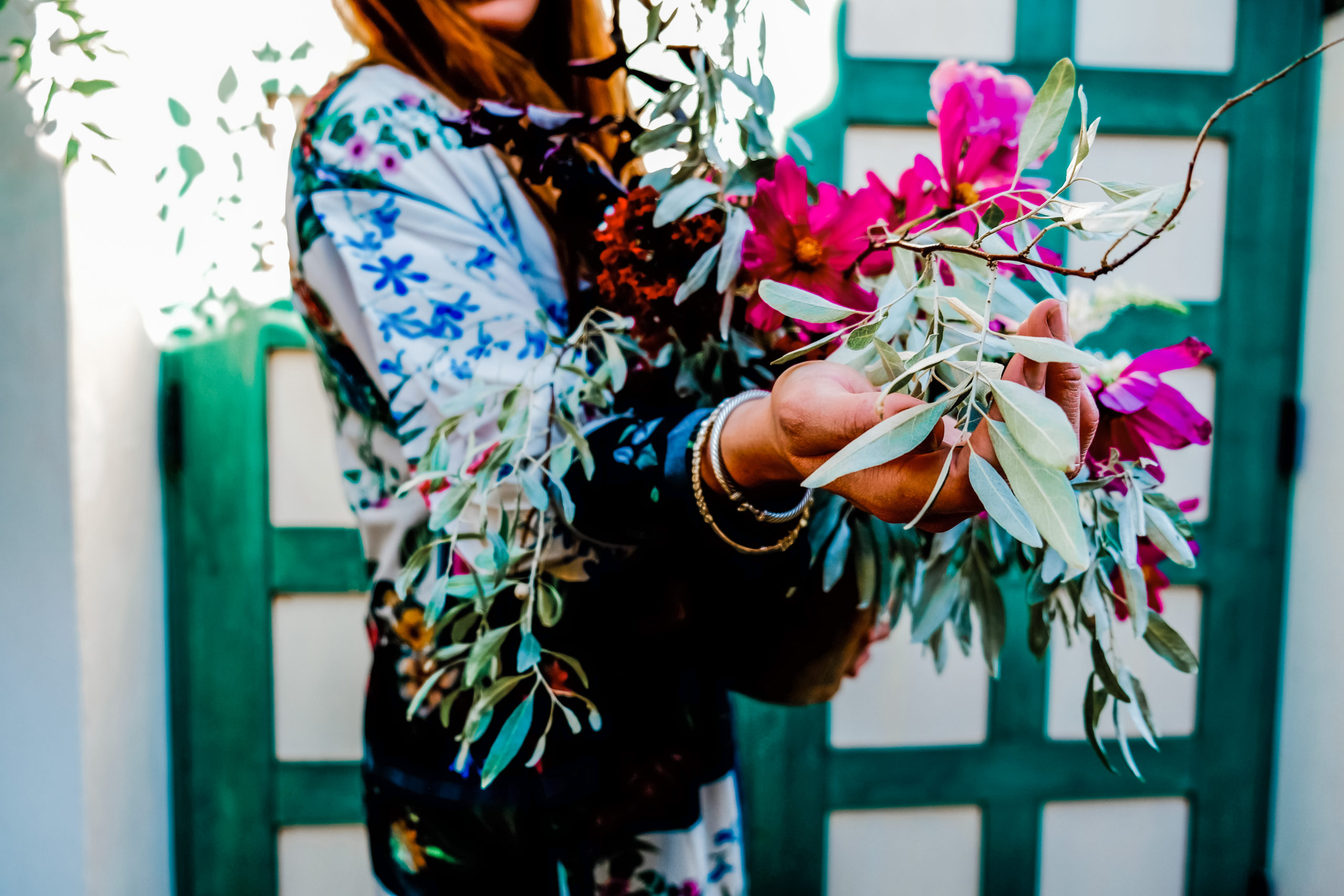
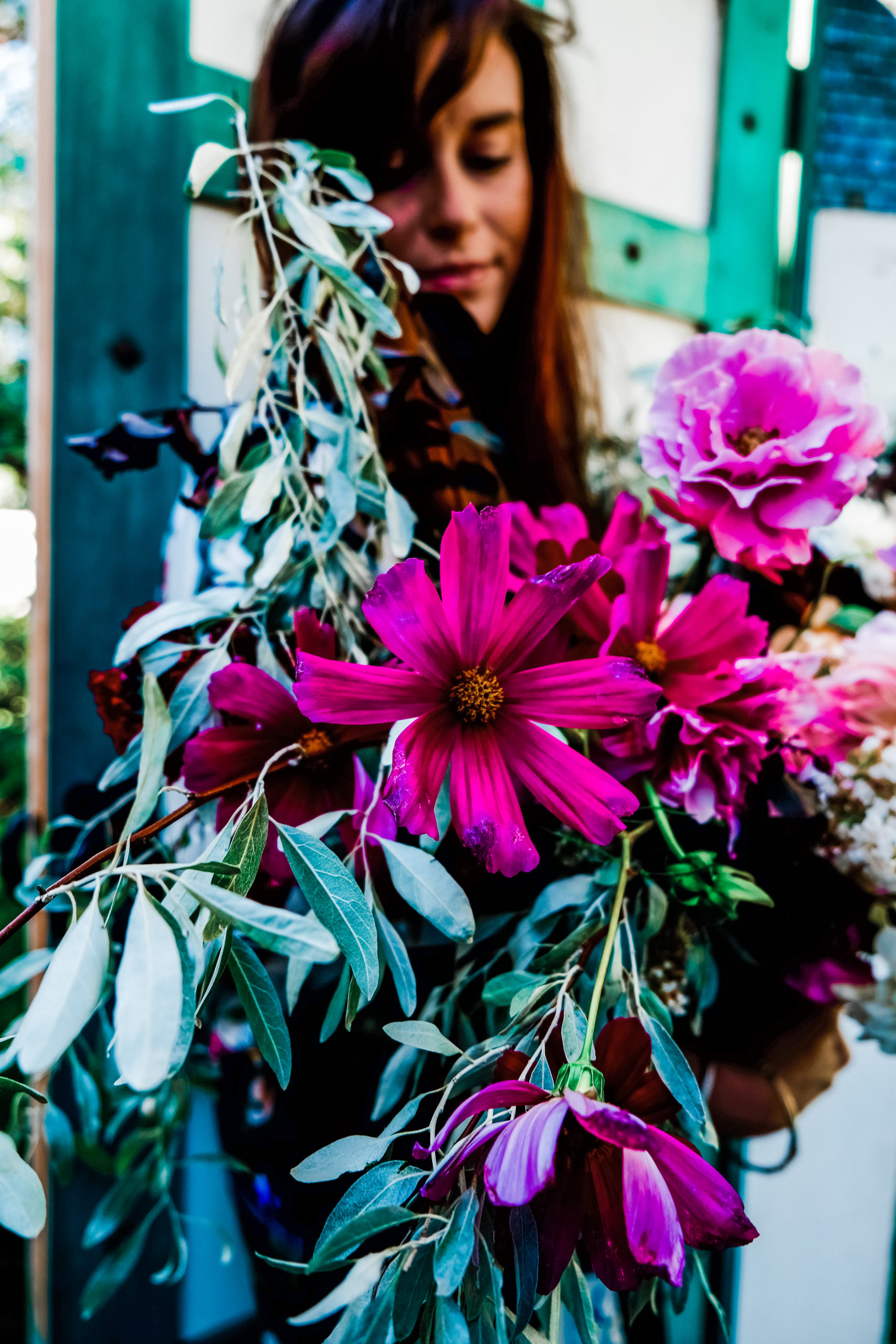 So what will we support? Which choices will we make? For me, foraging, gleaning, and growing, supports both my ethos and aesthetic. It makes me feel like a proper steward, and it gives me the gorgeous, weepy, tenderly alive flowers and foliages that I love. Given my current location, I will always have to supplement local product with product I purchase from a wholesale company. But I can challenge myself to source and ask for American grown product and keep anything out-of-season to a minimum. And I will go out and forage for the connecting elements, that give each order its infusion of real and seasonal and now.
So what will we support? Which choices will we make? For me, foraging, gleaning, and growing, supports both my ethos and aesthetic. It makes me feel like a proper steward, and it gives me the gorgeous, weepy, tenderly alive flowers and foliages that I love. Given my current location, I will always have to supplement local product with product I purchase from a wholesale company. But I can challenge myself to source and ask for American grown product and keep anything out-of-season to a minimum. And I will go out and forage for the connecting elements, that give each order its infusion of real and seasonal and now.
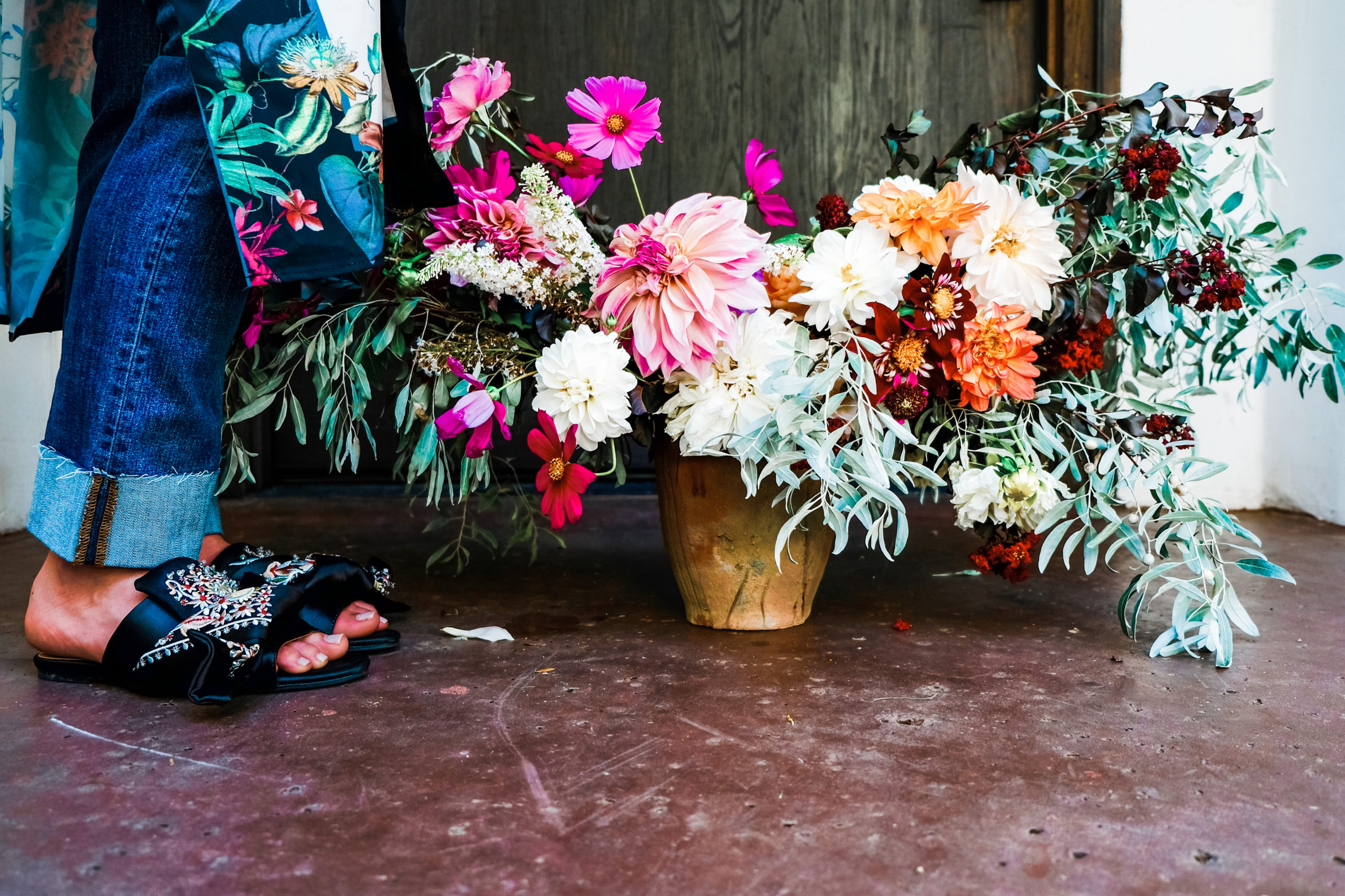
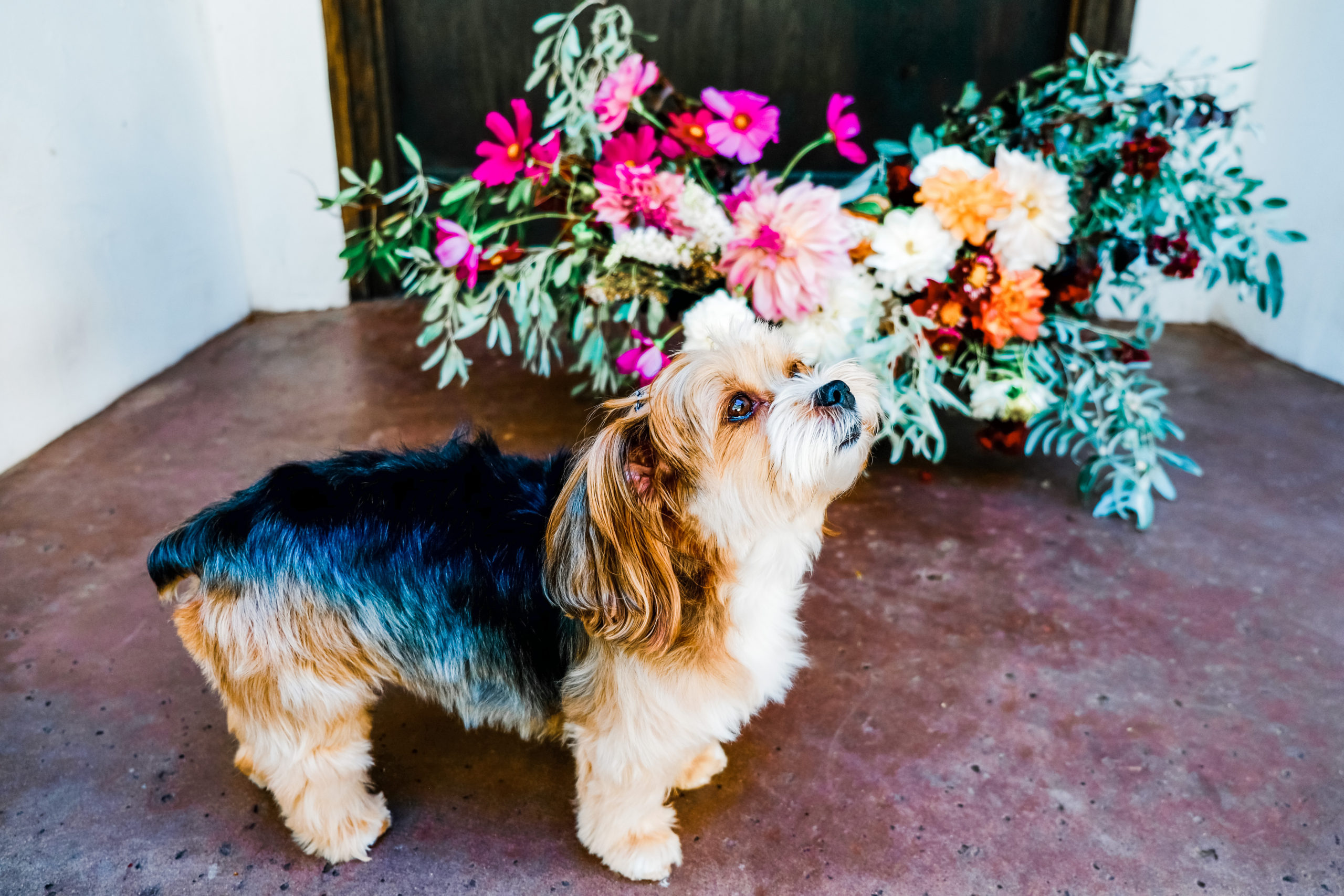
Beyond advocating for good flower behavior… I’m interested in the ‘why’ of all of this. So is Louesa Roebuck, author of Foraged Flora, and she really taps into this need that consumers have for their flowers to last inordinately long. Again and again, she circles around the question—when did we decide to privilege this one pristine stage of the life cycle? When did we stop considering the entire span, the peculiar beauty of each stage? We don’t take such a holistic approach to our flowers; we prefer them frozen in a state of permanent perfection.
(It’s not difficult to take this preference for preservation beyond flowers. We are a people who resist aging and physical decline. We fight nature and change on a very intimate level, through the care and keeping and sometimes extreme renovation of our own bodies. And we, of course, fight nature on a macro level; the story of us harnessing nature for our own purposes and ambitions is nothing new.)
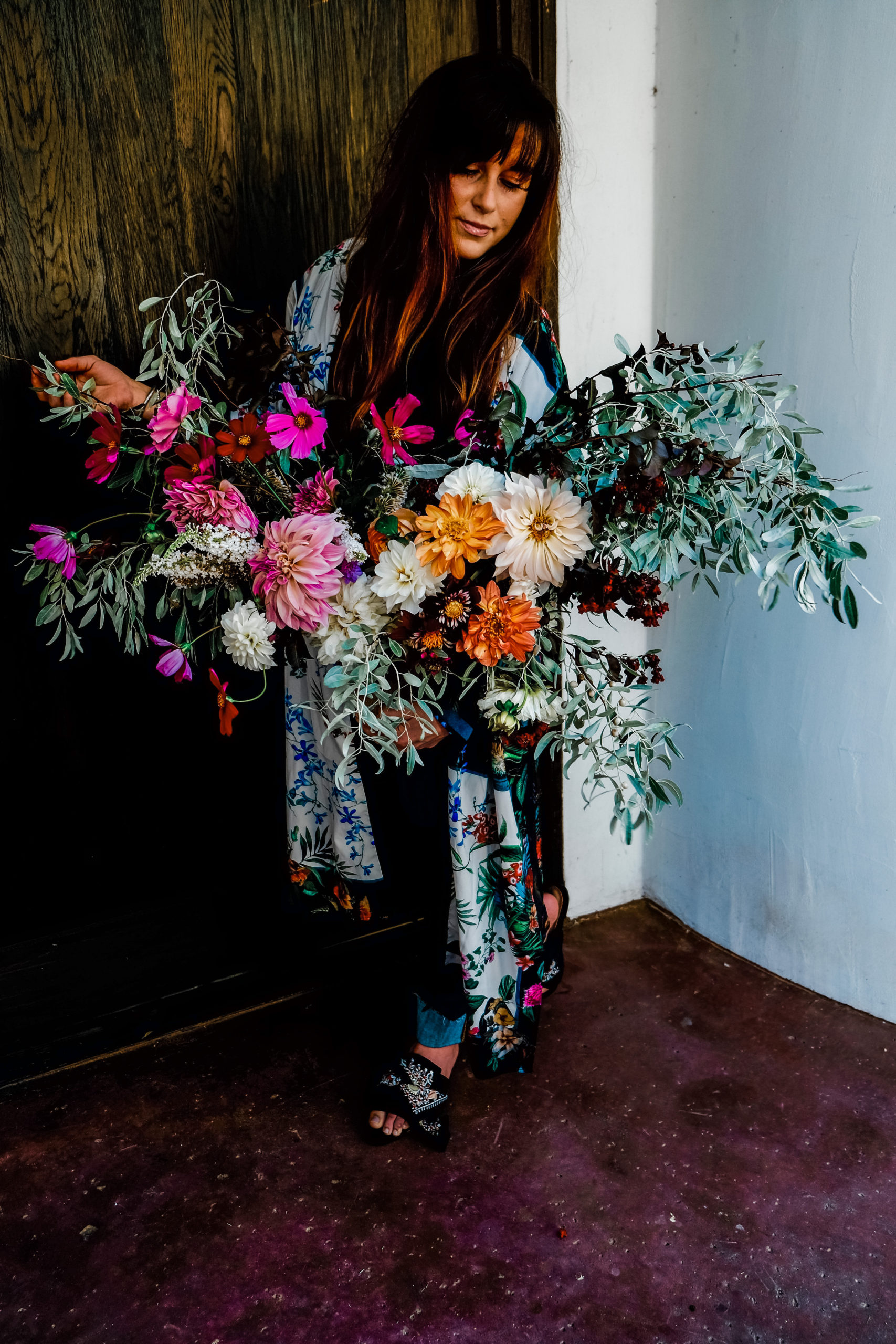
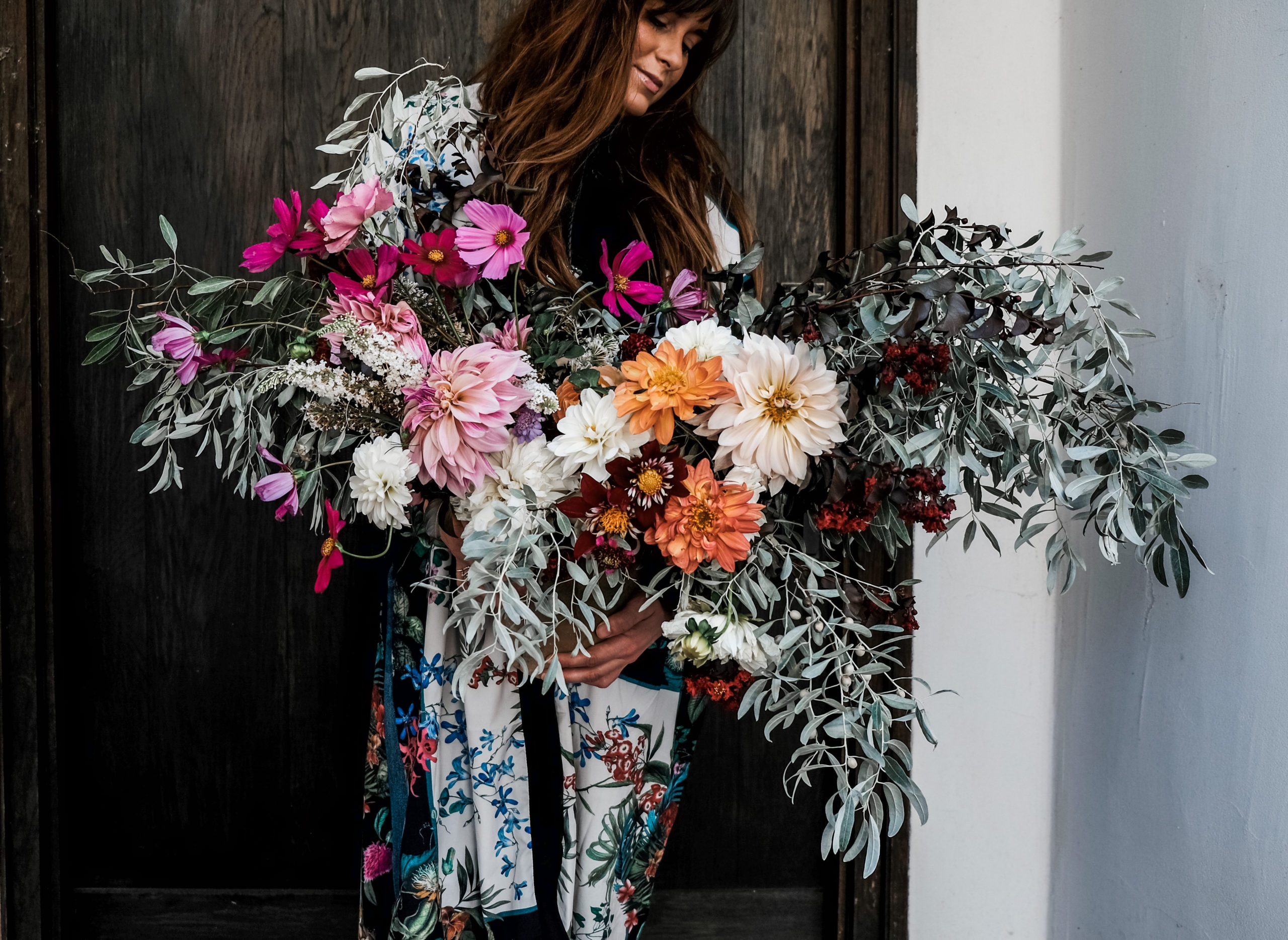
I think of a garden rose past its glory, or clematis gone to seed. My aesthetic tends toward asymmetry, imperfection, the intangible, the fading, the fleeting; I might seem inclined to love this sort of thing anyway. But I really did have to learn this; my love for imperfect flora happened over time. I had to learn how to see. The first few times my magnolia petals turned brown, I did not find it sentimental and beautiful. I wanted to throw them out. It was ingrained in me to want new and fresh and pretty, pretty, pretty.
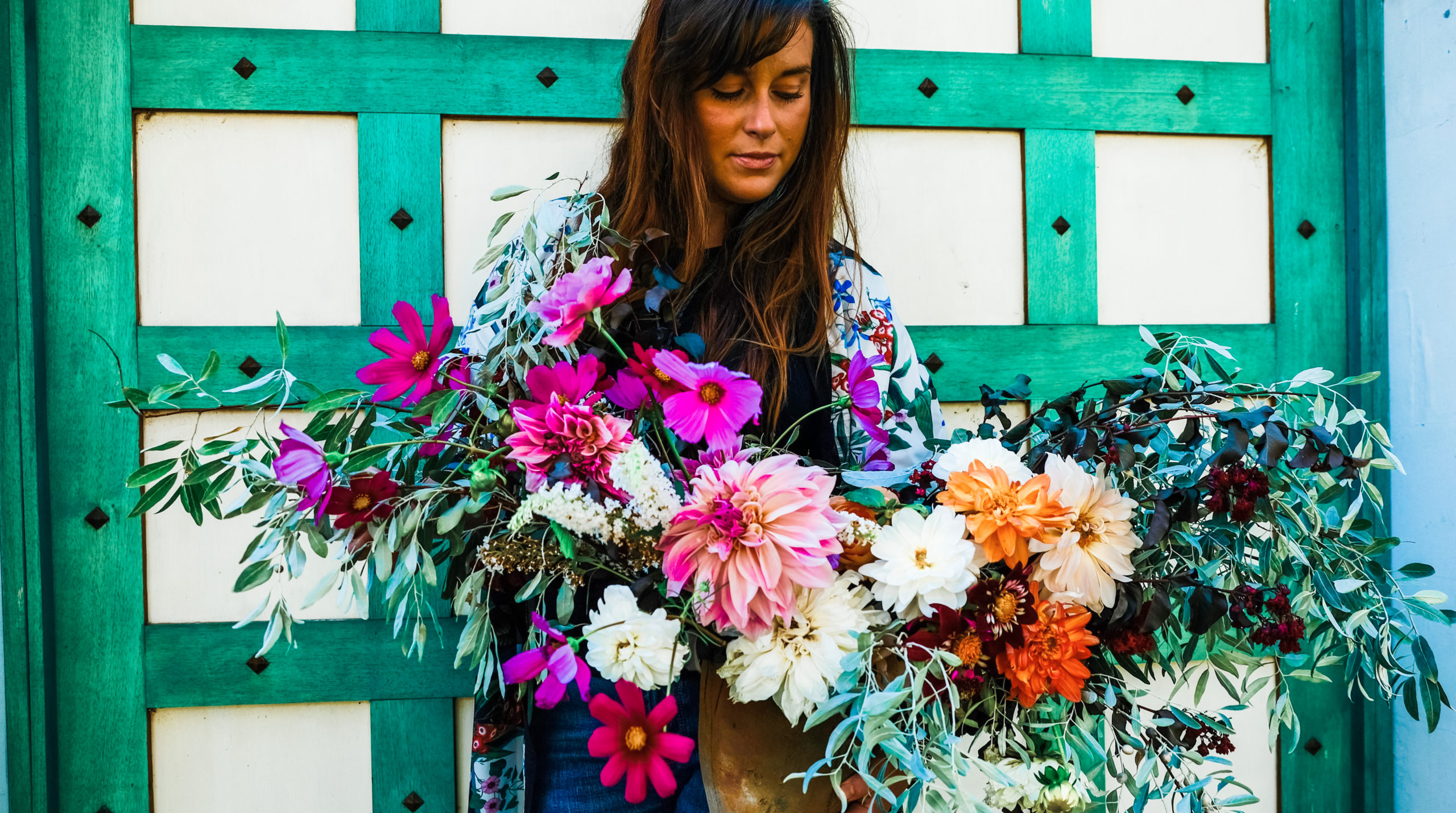
Maybe my newfound love for flowers was the product of harvesting them from my farm, their petals torn and dirty; they clenched my heart—I loved them. Maybe it was from my taking down branches and watching them fall in a pile, each unique, flawed, and together, unutterably exquisite. Whatever it was, gradually, I found that I love what is real. I love the things in nature that are the product of diligent, devoted growing. I love the things that I find in the wild and the things that ‘find’ me (spirea blooming in an alley, a shock of wisteria falling over a fence). This is what I prize in a flower, or foliage, or any aspect of the nature: the sense of its being real. Grown in soil that is honest and good. Found in whatever stage of being that I find it in. Alive, vibrant, here for this moment. No artificial perfection. Nothing harmful to prolong its life.
An aside. This approach to my working and creative life has brought interesting (and unlooked for) benefits to my personal life. It was perhaps natural to appropriate the ‘beautiful at every stage of being’ argument to, well, myself. And I don’t think I realized how very much I was straining under the burden of trying to always look and be 21 (forever 21! Haha. It’s so bad I’m leaving it here). I don’t know, 21 was a pretty age for me, but I’m glad to be past it; I don’t need to revisit it. I have a newfound love for age-appropriateness. For acting one’s age, yes, and settling into the wisdom, the peace, the intelligence that every year offers. It’s sexy and cool to own it all. It’s immature and frankly kind of creepy to try to act, look like, recapture, or revisit some younger stage. Thanks, but no thanks.
My dahlias, as of this morning, have faded from their former glory, and many of my garden cuttings look, well, older. (And “I’m getting older toooooo…..”) I am glad I no longer have to resist the urge to throw them away or hide them behind younger, livelier stuff. Instead I gave the arrangement an admiring glance, changed its water, and let it be. If I want something new, I’ll go out and find it, or plan to grow it.
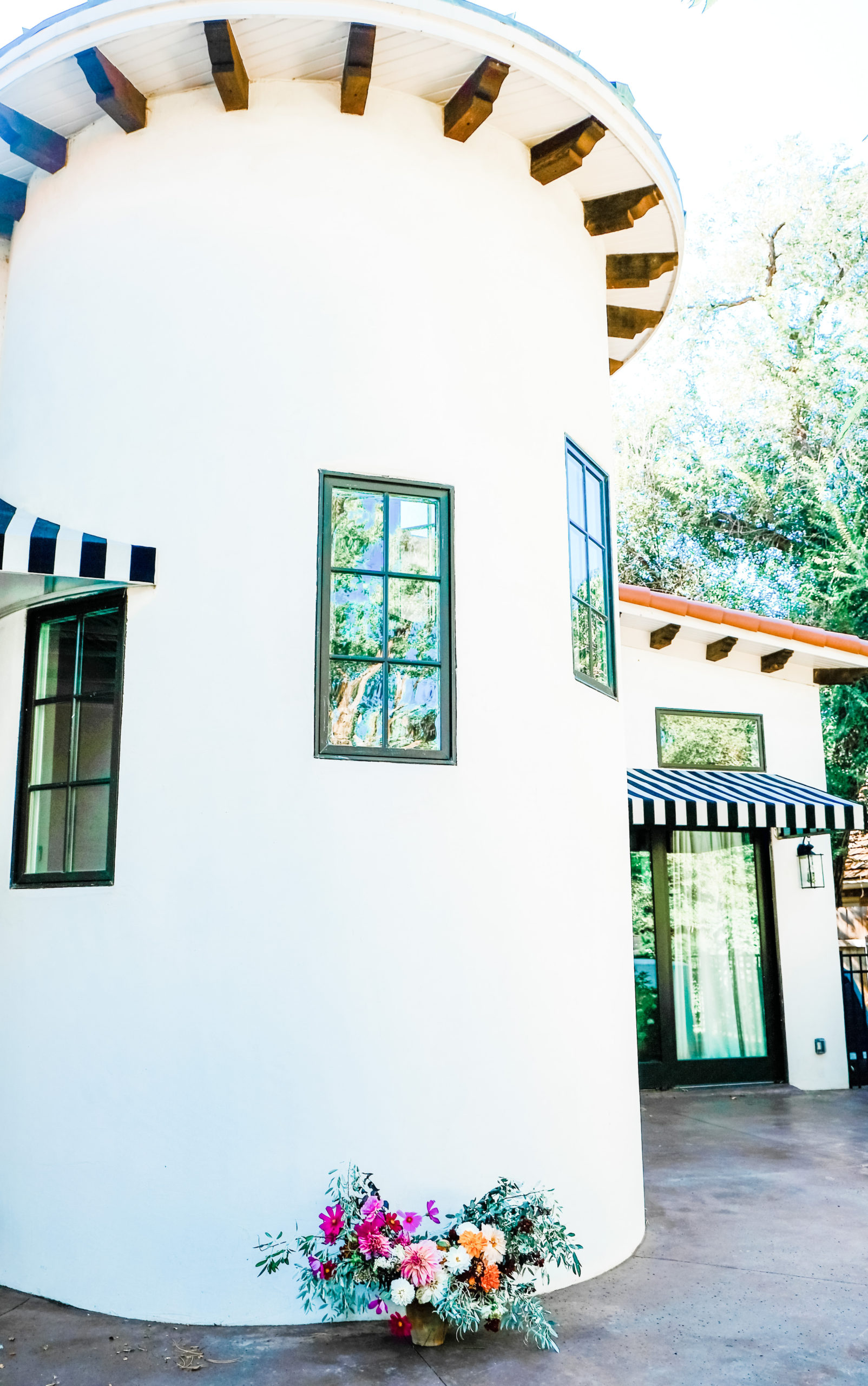
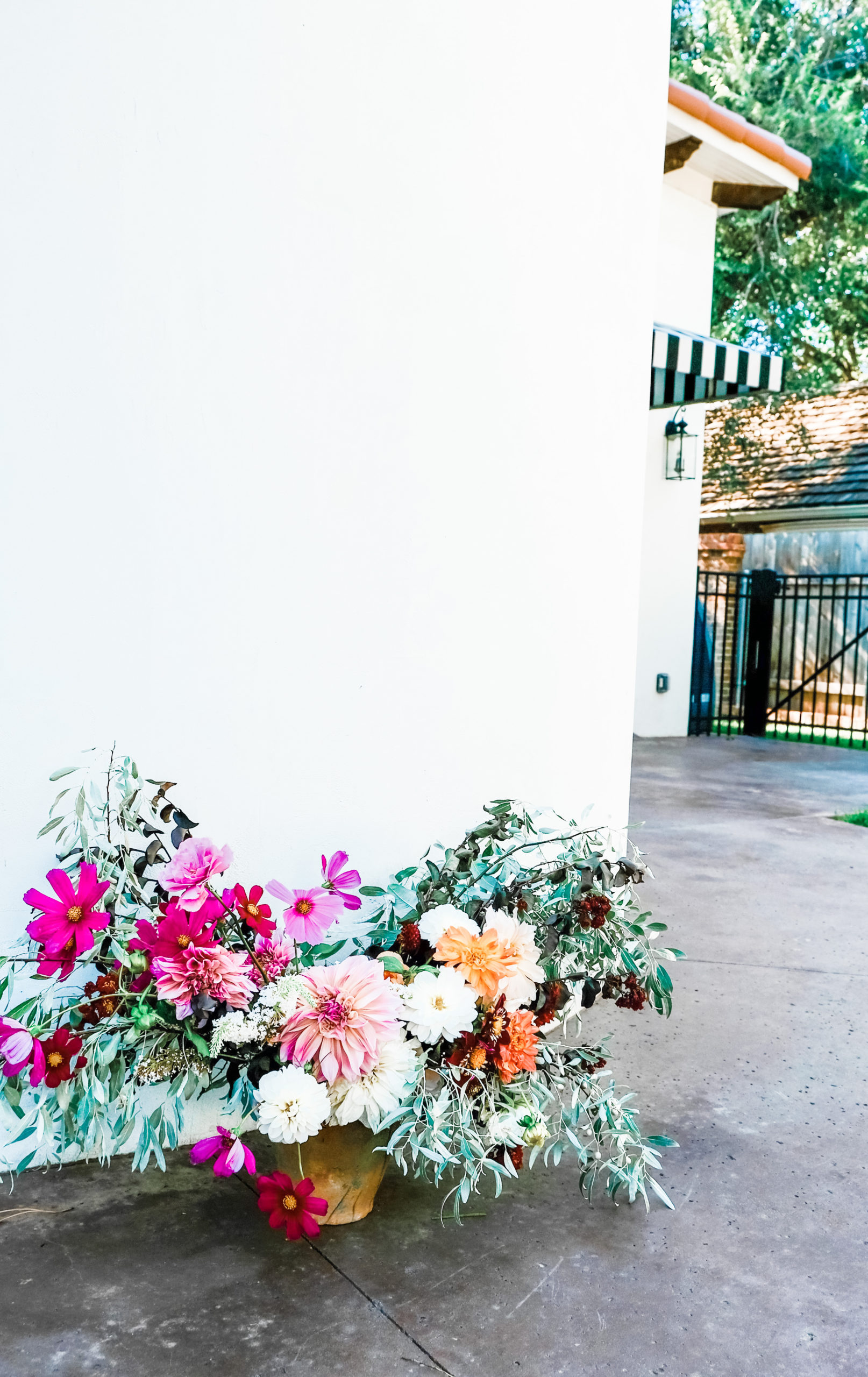
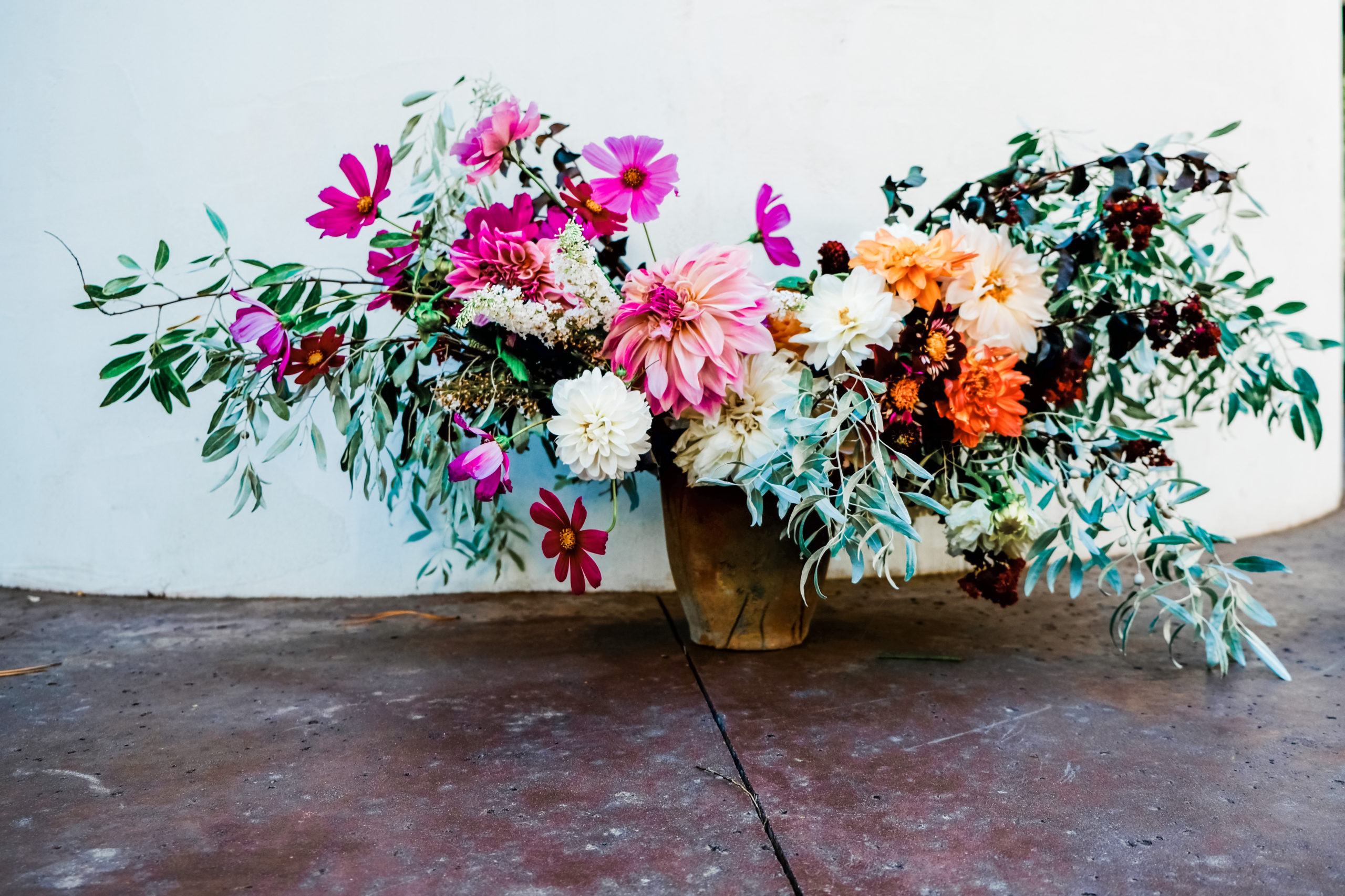 Maybe what’s needed is a shift in the way we think about food, flowers, and beauty. I’m not proposing that we all become expert foragers or grow our own food (although that would be lovely and utopian). But we can certainly choose who we support. We can learn to love things that are fleeting, and savor them for the present moment. And we can learn to look with grace upon those things we would normally consider blemished, faded, past their prime. It’s all part of the same, intelligent cycle that gives us moments of beauty, and their fading, and their renewal. And it’s an honor to participate in that cycle at any stage.
Maybe what’s needed is a shift in the way we think about food, flowers, and beauty. I’m not proposing that we all become expert foragers or grow our own food (although that would be lovely and utopian). But we can certainly choose who we support. We can learn to love things that are fleeting, and savor them for the present moment. And we can learn to look with grace upon those things we would normally consider blemished, faded, past their prime. It’s all part of the same, intelligent cycle that gives us moments of beauty, and their fading, and their renewal. And it’s an honor to participate in that cycle at any stage.
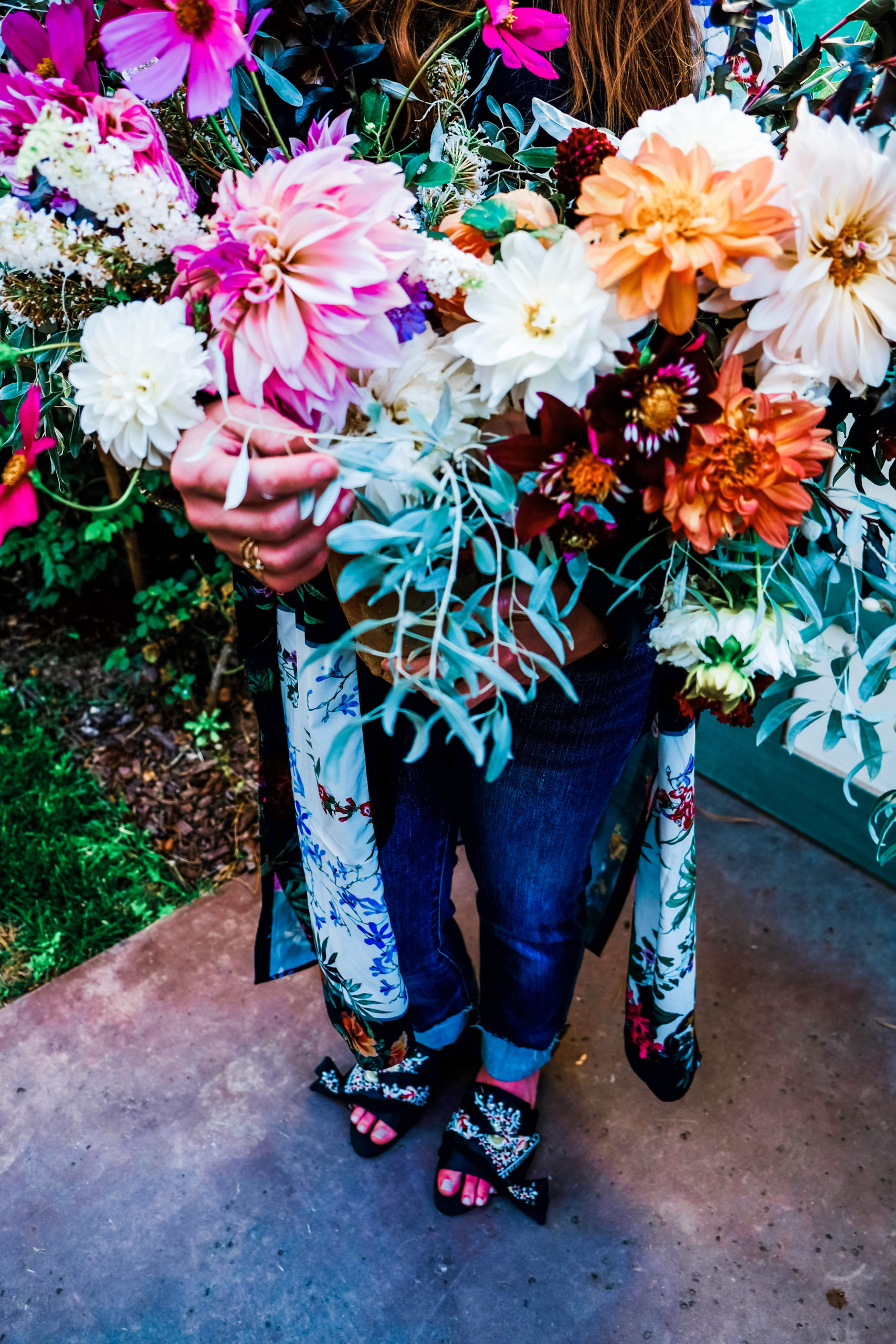
And, because I find this sort of thing entertaining, a “greatest hits of foraging” list to end things. Because I can distinguish certain chapters of my life by the flowers I was picking, then—just as people use songs as a bookmark for certain seasons.
The alpine wildflowers of my childhood.
Wild flax & gentian flowers on Vail hikes and walks.
Bouquet-making in New Mexico, at age three-ish, wearing a Benetton t-shirt and a pair of hiking boots that I now envy.
The daisy chains, the clover chains, the endless circles of white. I still find them pressed between pages of my earliest diaries, crumbled bits of clover that take me right back. My favorite ones, I made in Mount Rainier on a hike where I should have been enjoying the more epic scenery.
The soapberry branches I cut down one January, missing flowers, desperate for nature, for even one single berry.
The magnolia I foraged at midnight, in high summer, its leather petals creamy at first then fading to a tawny color.
The spring of spirea, lilac, wisteria, redbud, cherry blossom, lacecap hydrangea, trumpet vines, honeysuckle; everything lacy and delicate or rambling and prolific. I was practicing ikebana style arrangements. On my birthday, I made countless of these almost entirely from things I had foraged. I had never been more in love with flowers.
The huge heaps of flowers my then-boyfriend left on my jeep, usually an apology but sometimes a declaration of love. From his cuttings, I made blue bouquets of flax & cornflower.
The magnolia we stole as everything was ending, a desperate and kind of sad attempt to recapture the excitement of our first days together.
Wild grape vine that I like to pull down in long, pretty strands.
A particularly lost trip to Wyoming, which was a beautiful place to be lost in. I foraged flowers on morning bike rides, and tucked them in some guy’s backpack for safekeeping, where they were left to die. I asked to pull over the side of the road and walk the fields at evening, because walking the fields at evening is basically the embodiment of my heart and soul. The Tetons were my backdrop, and the fields not dissimilar from the ones I walk in my dreams and daydreams, fingers grazing gold. The guy was in the background protesting about mosquitoes, clearly oblivious to or insensitive of the transcendent moment I was on the cusp of having. I had to walk out of my reverie and into a cloud of Off! and complaints. That feeling of disconnect and of trying to force a non-existent beauty pretty much defined that whole… time period, so…
An undiscovered juniper tree that we found on a styled shoot. We tucked berried bits of green into wild and wintry bouquets.
The first flowers I ever grew, zinnias that flowered on Father’s Day.
Dahlias from my cutting garden, magnificent dinner plate varieties with layered colors and a distinct, clean, almost mint fragrance.
The pink branches I foraged for a blog post here, wearing a pink spring dress and light spring sweater, feeling sad but concerted by the first signs of spring.
Russian olive that I forage for every wedding installation, the perfect touch of silver and drape-y.
Flower hauls I make for no particular reason, save to have flowers in my hands again.
